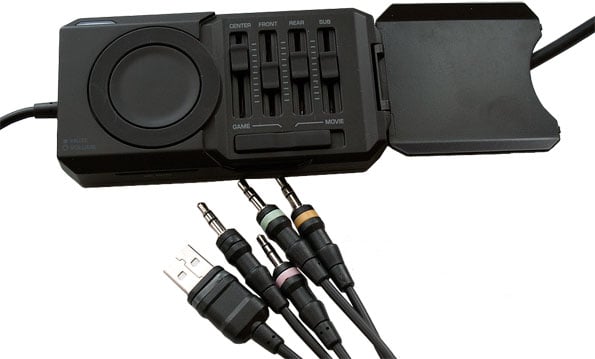Sound Advice: Five Gaming Headphones Tested
|
| Headphones | |
| Frequency Response |
20Hz - 20kHz |
| Max SPL at 1KHz | 114+/-3dB |
| Max input power | 100mW (30mW) |
| Drivers (Front) |
40mm |
| Drivers (Rear) |
40mm |
| Vibration Driver Units | |
| Frequency response |
1000mW |
| Driver |
30mm |
| Microphone | |
| Frequency response |
20-18,000Hz |
| Sensitivity at 1KHz |
-36dB |
| Directivity |
Omni-directional |
| MISC | |
| Price |
~$120 street |
| Warranty |
1 year |
Design and Comfort

The Kave adjusts to wrap around large heads too, and everything in between. One thing that's immediately apparent when you slip your head into the Kave is the weight, especially within the ear cups. Keep in mind that it's toting additional drivers for 5.1 channel audio, so a bit of additional heft is to be expected. It doesn't feel like a bag of bricks, but you're not going to forget you're wearing them the way you would a baseball cap (as opposed to, say, a football helmet).
Aesthetically, the Kaves look sharp and feature a rubberized coating on the ear cups. That means they're less prone to fingerprints, especially compared to glossy finishes. We also have to give Roccat props for the thick metal band that extends from one ear cup to the next. These might be the sturdiest headphones of the bunch, which is another reason why they're a little heavier than the others.

A volume wheel rotates like a classic iPod to adjust the volume up or down, and in the center is a gigantic mute button. If you want to mute the microphone, there's a separate button on the side of the remote. When muted, the tip of the mic glows blue, providing a gentle reminder that your teammates can't hear your instructions (and if it isn't glowing blue, they're just ignoring you).
A lid opens up above the volume wheel to reveal independent volume controls for the different drivers, including center, front, rear, and sub. If you're only using stereo mode instead of 5.1 channel audio, just the front dial will do anything, as you're not taking advantage of all the drivers.
Sound Quality
We were a bit surprised that Roccat didn't include any special drivers or setup software with the Kave, nor will you find any on the company's website. However, bear in mind that in order take full advantage of the Kave, you need either a dedicated soundcard or onboard audio that supports 5.1-channel audio.In lieu of custom drivers or setup software, Roccat includes a 5.1 surround sound demo to show off the positional audio (and to get you excited about the headphones you just purchased). There's also a folder full of wallpapers and a user manual in PDF form.
We started off our testing by listening to music in stereo mode. Sonically, the Kave's range is similar to the other headsets in this roundup, though for better or worse, bass performance doesn't dominate the sound spectrum. If you like a lot of bump with your grind, the Kave will leave you wishing for a little more than it can provide. Conversely, if you've always wanted a gaming headset that doesn't overemphasize the low end, the Kave is calling your name.
On the other end of the spectrum, the Kave doesn't hit the highs like an opera singer, and neither do any of the other gaming headsets reviewed here. But it does do a good job with what its got. We really enjoyed the raspy highs from Audra Mae & The Forest Rangers singing, well, just about anything, but in particular The Unclouded Day (from Sons of Anarchy) and Forever Young.
Stereo sound isn't the Kave's playground, however, so we unleashed the headset on several 5.1-channel samples and gaming titles that support it. This is where the Kaves really shine, so long as you adjust your expectations. Even with the angled drivers, the Kaves are no match for a 5.1-channel speaker setup. But as far as headphones go, they do a remarkable job letting you know where the sound is coming from. The effect is especially enhanced if you tweak the individual volume dials; we found the best results by turning down the front volume a quarter of the way while leaving the rear dial cranked up.
You'll also want to spend some time playing with your soundcard's equalizer settings, if available, to put a little more emphasis on the lows. That's were the most fun is had when playing games, and the Kaves stop a little short of delivering bone crunching blows on the low end.









